Leo_Chan
Senior Member
A video would be more understandable. A picture can say 1000 words. A video can say 1000000 words (or ~21-30 pictures  ).
).
Yes, that's pretty standard. Makes a bit more sense when you see it happening, and what preceded it (just the red) than looking at a photo.
Which it isn't in North America, where most cars that are sold are automatics. Plus most of the world is going away from Standard transmissions too. Most of the supercars now are automatic with flappy paddle shifting.When the majority of cars are standard it allows them to get them in gear and ready to motor when it does turn green.
Which it isn't in North America, where most cars that are sold are automatics. Plus most of the world is going away from Standard transmissions too. Most of the supercars now are automatic with flappy paddle shifting.

Which it isn't in North America, where most cars that are sold are automatics. Plus most of the world is going away from Standard transmissions too. Most of the supercars now are automatic with flappy paddle shifting.
more details at:From CP24:
http://www.cp24.com/news/city-installing-smart-signals-at-22-intersections-1.3692182
InSync and SCATS. Who comes up with these names??
AoD

)

)
Musicians and (for certain) not biologists?From CP24:
http://www.cp24.com/news/city-installing-smart-signals-at-22-intersections-1.3692182
InSync and SCATS. Who comes up with these names??
AoD
I don't know the timings, but here is how it works.
Except for major intersections:
Lights are timed to match the movements of the streetcar such that the cross traffic lights are green and the streetcar lights are red when the streetcar approaches the stop. When the streetcar comes to the stop, the lights begin their change from green/walk, to red/don't walk. At this point, the streetcar should be loaded and ready to go. They can now move due to it being green for them.
Major intersections would need better timing to take in consideration the traffic patterns and the streetcar passenger load.
You could try the Salt Lake City solution.Pedestrian crosswalks have additional lighting overhead.

Yet, at traffic signal intersections, there is no additional lighting other than the normal street lightning.
)
Maybe using LED lights that light up the path at night when pedestrians have the green.

Making the intersection crossing brighter would benefit the pedestrian, so there is no funds to improve such safety.
)


On another note, perhaps a quick fun test: what does a motorist do when facing (a) a dead traffic signal (i.e, the power's out) and (b), they are flashing red and amber for opposing directions (i.e the signal's logic has failed)?




